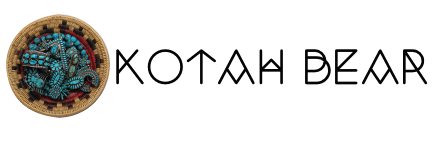Care Instructions
Native American jewelry from the Southwestern United States is typically made using sterling silver and a variety of semi-precious stones. These pieces require some consideration in their care but should yield many years of enjoyment with the proper attention. They can also be repaired, should they break!
Please avoid bringing your Kotah Bear jewelry into contact with hand sanitizer! This is a very strong substance that can result in damage to the jewelry.
It is best to remove your jewelry, especially rings, when washing your hands, bathing, showering, doing the dishes etc. Our items, particularly inlay, are made of many small pieces of stone and shell that are glued to a backing and to each other. Getting this wet will allow water to weaken the bonding and loosen it over time.
Sterling silver is also known as a fairly 'soft' metal and you can bend/break most items yourself with enough effort. Care should be taken to avoid undue strain on the sterling silver for this reason. When bending a cuff bracelet to fit, take care to adjust the silver part only, to avoid placing excess strain on the stones that have been set into the cuff. If you notice a turquoise or other stone coming loose after wear, if the sterling silver bezel has gotten bent, take the back side of a spoon and gently tighten the bezel by pressing the silver back around the stone.
It’s safe to surface clean turquoise jewelry with a damp microfiber cloth, being careful not to immerse or soak the piece, as some Native American pieces use a traditional method of laying the stones on a soft bed of sawdust to prevent breakage. Most turquoise jewelry should never be cleaned with steam or ultrasonic cleaners. Turquoise is generally stable to light, but high heat can cause discoloration and surface damage. It can be discolored by chemicals, cosmetics, and even skin oils or perspiration.
While storing necklaces or bolo ties, make sure to lay them flat, taking care not to curl the item so they will hang nicely when worn.
Contact with household chemicals, perspiration, rubber, chlorinated water, or any substances which contain sulfur (e.g., mayonnaise, eggs, mustard, onions, latex, wool), will cause corrosion and tarnish — so it’s a good idea to remove silver jewelry when doing household chores. Direct sunlight also causes silver to tarnish, so be sure to take off your silver jewelry before you go swimming and sunbathing.
For some pieces, the artisan will intentionally allow or treat the sterling silver so it will darken and oxidize, allowing certain areas to stand out more. This detailing can be lost with excessing cleaning and polishing, so be careful with your items that are purposefully oxidized.
Lotions, cosmetics, hair spray and hair products, and perfumes are also “enemies” of silver and will accelerate tarnishing, so it is a great idea to put on your jewelry as a last step to getting ready!
As exposure to air tarnishes it, storing silver in airtight plastic bags with anti-tarnish strips is a great preventative measure. Just make sure you don’t store multiple jewelry pieces in the same bag: silver is a soft metal, so the individual pieces can scratch each other. Link or chain bracelets should be kept unclasped or unhooked to prevent scratching as well. If you can’t use plastic bags, try to make sure that the storage area has low humidity. You can also place a piece of chalk, a packet of activated charcoal, or a container of silica gel in the storage area to minimize tarnish.
You can use a special silver cloth to polish your items, but a lint-free flannel, microfiber, or other soft nonabrasive cloth will do as well. Do not use paper towels or tissues to polish your jewelry as they contain fibers that can scratch the silver. Simply polishing your silver works well when the tarnishing is not too severe. It’s also the best method for cleaning oxidized silver, as you can stay away from the intentionally tarnished areas. Take special care not to polish the stones in your jewelry while polishing the silver as this may affect their appearance.
When polishing, use long back-and-forth motions that mirror the grain of the silver. Do not rub in circles, as this will magnify any tiny scratches. Also, change to a different section of your cloth frequently to avoid placing tarnish back on the silver. You can use a Q-tip to get into small, detailed areas. But if your pieces are heavily tarnished and you don’t have the time to clean them, take them to a professional. Very old, fragile, or valuable pieces should also be cleaned by a professional.
We wish you and your Kotah Bear jewelry many years of enjoyment! If you have questions or concerns, please reach out at https://kotahbear.com/pages/contact-us or email us at kotahbearcares@kotahbear.com
